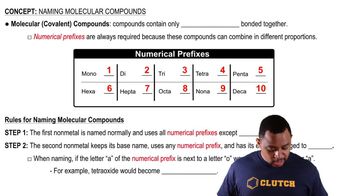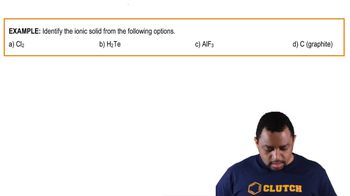Here are the essential concepts you must grasp in order to answer the question correctly.
Ionic Compounds
Ionic compounds are formed when atoms transfer electrons, resulting in the formation of charged ions. These compounds typically consist of a metal and a non-metal, where the metal donates electrons to become a positively charged cation, and the non-metal accepts electrons to become a negatively charged anion. The electrostatic attraction between these oppositely charged ions holds the compound together.
Recommended video:
Molecular Compounds
Molecular compounds are formed when two or more non-metal atoms share electrons through covalent bonds. Unlike ionic compounds, molecular compounds do not consist of ions but rather discrete molecules. These compounds often have lower melting and boiling points compared to ionic compounds and can exist in various states (solid, liquid, gas) at room temperature.
Recommended video:
Naming Molecular Compounds
Identifying Ionic vs. Molecular
To determine whether a compound is ionic or molecular, one can examine its constituent elements. Compounds formed from metals and non-metals are typically ionic, while those formed from non-metals are molecular. Additionally, the presence of a polyatomic ion can indicate an ionic compound, while the absence of such ions and the presence of covalent bonds suggest a molecular compound.
Recommended video:
Ionic Solid Identification Example
 Verified step by step guidance
Verified step by step guidance


